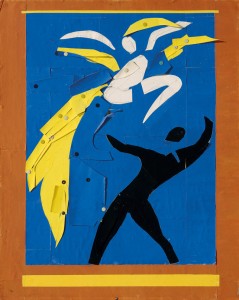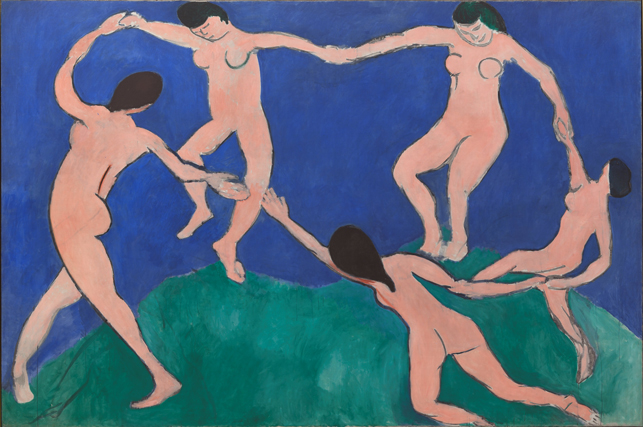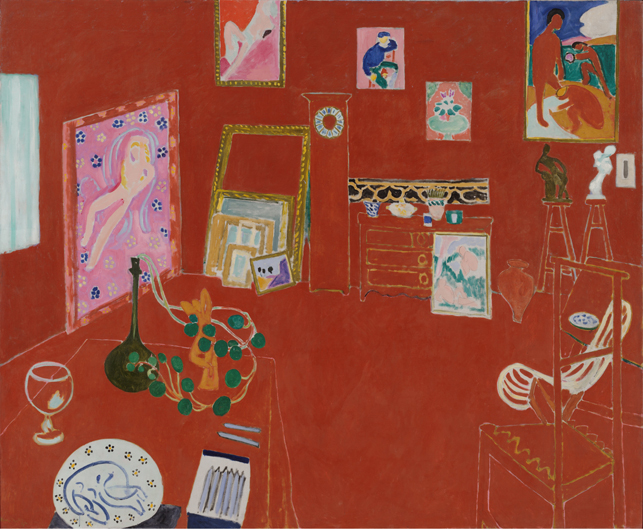NOVEMBER 11, 2014 | ARTISTS, COLLECTION & EXHIBITIONS
Matisse: The Same Thing, Different Means

Henri Matisse. Two Dancers (Deux danseurs). 1937–38. Stage curtain design for the ballet Rouge et Noir. Gouache on paper, cut and pasted, notebook papers, pencil, and thumbtacks, 31 9/16 x 25 3/8” (80.2 x 64.5 cm). Musée national d’art moderne/Centre de création industrielle, Centre Georges Pompidou, Paris. Dation, 1991. © 2014 Succession H. Matisse / Artists Rights Society (ARS), New York
Henri Matisse: The Cut-Outs, currently on view in the Museum’s sixth floor temporary exhibition galleries, looks closely at the works Matisse created in the final decade of his career. Adopting painted paper as his primary medium, and scissors as his chief implement, he invented a radically new form that came to be called a cut-out. But while this work was utterly new, its concerns were consistent with those that had driven Matisse throughout his entire career. In a 1951 interview, the artist expressed the consistency of his pursuit: “From the Joie de vivre—I was thirty-five then—to this cut-out—I am now eighty-two—I have remained the same…because all this time I have searched for the same things, which I have perhaps realized by different means.” So while you’re waiting for your timed-ticket entry to see The Cut-Outs, or after you’ve taken them in, be sure to visit the Matisse masterworks on view in our Painting and Sculpture Galleries on the Museum’s fifth floor, to see what came before.
Some of the earliest works in Henri Matisse: The Cut-Outs relate to dance. The artist used cut paper in the early 1930s to plan the Barnes mural’s tumbling dancers, and in the late 1930s to design the sets and costumes for a ballet called Rouge et Noir. But perhaps his most famous treatment of dancers can been seen in Gallery 7 on the fifth floor. In Dance (I) (1909), Matisse sets a whirling circle of nudes into rhythm against a flat background of deep blue and green—sky and grass. A compositional study for a decorative panel commissioned by the Russian collector Sergei Shchukin, Dance (I) anticipates the ambitiously scaled commissions Matisse would realize in cut paper forty years later.

Henri Matisse. Dance (I). Paris, Boulevard des Invalides, early 1909. Oil on canvas, 8′ 6 1/2″ x 12′ 9 1/2″ (259.7 x 390.1 cm). The Museum of Modern Art, New York. Gift of Nelson A. Rockefeller in honor of Alfred H. Barr, Jr. © 2014 Succession H. Matisse/Artists Rights Society (ARS), New York
As the cut-outs grew in scale from the intimate to the monumental, Matisse could no longer compose them on a small board, and they migrated to the walls of his studios. Archival photographs show the studio walls as a ground for ever-shifting arrangements of colorful cut-paper forms. But long before the studio served as the canvas on which the cut-outs were made, it constituted a central subject in Matisse’s paintings. In The Red Studio (fall 1911), for example, Matisse depicts the milieu of his Issy-les-Moulineaux workspace, with canvases stacked and sculptures perched on stools. The way he describes the outlines of a table, a chair, a grandfather clock—thin outlines in a sea of red—foreshadow the way he would, at the end of his career, “cut directly into vivid color.”

Henri Matisse. The Red Studio. Issy-les-Moulineaux, fall 1911. Oil on canvas, 71 1/4″ x 7′ 2 1/4″ (181 x 219.1 cm). The Museum of Modern Art, New York. Mrs. Simon Guggenheim Fund. © 2014 Succession H. Matisse/Artists Rights Society (ARS), New York
沒有留言:
張貼留言